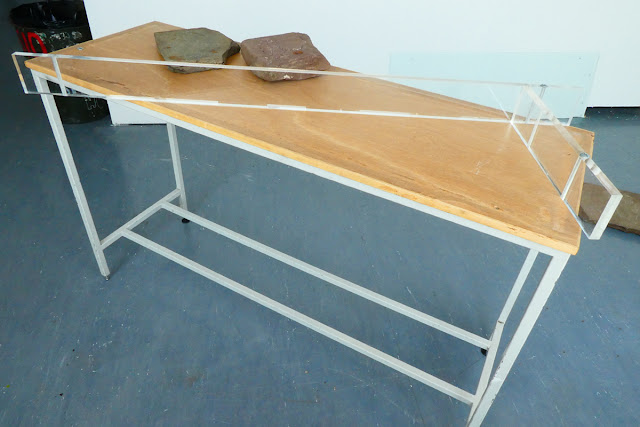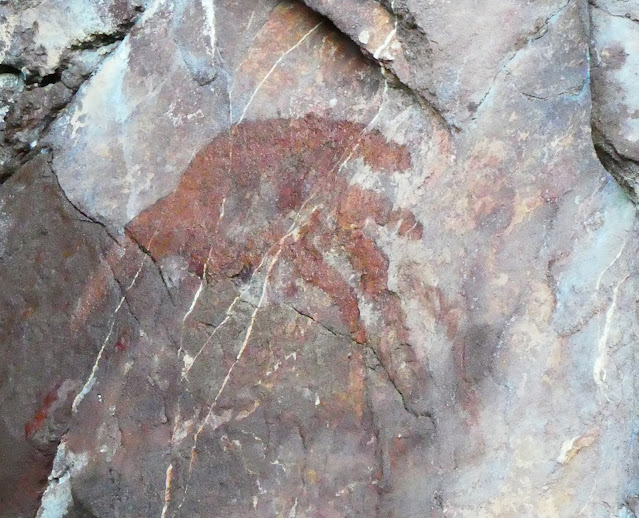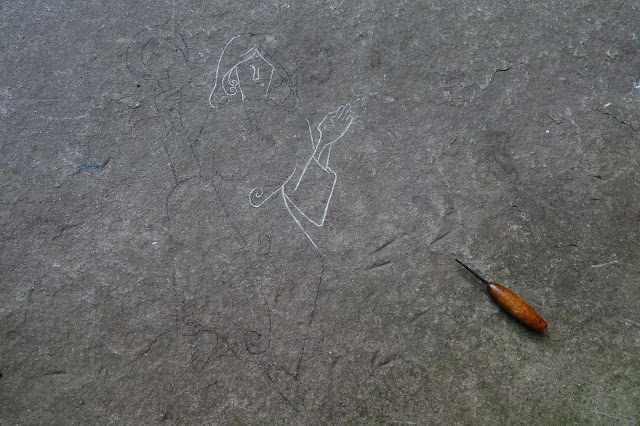Curating the Exhibition
Monday's curatorial session went well, with new ideas developing from the first, and seeking ways to successfully deconstruct the 'museum' concept - whilst still keeping the recognisable trappings of what constitutes a 'museum' present.
I experimented with the display case, which has been completely dis-assembled. I decided to use it as the means of 'shepherding' the audience around the display, in an anti-clockwise spiral which is perhaps counter-intuitive - as is the placement of the 'big' (i.e formal, clean, detailed and therefore - by general museum curatorial standards - more 'important') stone at the end of this journey. The first stones the visitor would encounter in this set-up are the cruder, less-skilled engravings; the memorial stone and the 'votive' offering stone, currently at the front of the show.
The glass top of the case was a bit of a problem - but, leant against a corner (itself a 'marginalised' space), it seemed to gain a new form and resonance. It also reflects the visitor - making the public a part of the exhibition. This is echoed by the 'democratization' inherent in the whole work, in which the usually marginalized figures, forms and voices are centralized (non-humans and non-males in the text; unskilled craftsmen, as in the above-mentioned display concept; and now, unrehearsed readings of passages from the text by my studio colleagues - giving an oral return to the origins of the epic, of stories, fairy-tales, legends, and their tellers) - breaking down the boundaries between the voice and figure of authority (the poet, the curator, the translator) and the recipients of that body of channelled knowledge, the people. Quite how the audio of these readings will be able to be heard in the space is another matter, although the idea of presenting the text also in a non-physical way seems to good to ignore. In this way, the audio is another 'middle space' between the text, and the recipients of that text.
Next questions are the material choices for presenting the text pieces (not the book, but rather the printed excerpts and 'information sheet') and how these will be arranged. Large areas of negative white space need not be avoided, given my interest elsewhere in the concept of void as a positive (Eastern) idea. Even the choice of font to use is a consideration - is there a 'standard museum typeface'? Should I use this, or oppose it? We considered even creating one or two uncarved (or unfinished) stones to add to the floor display - perhaps in a nod to Carl Andre? - and the whole ontology of objects and raw materiality.
As far as presenting the book itself goes, I'm in the middle of seeking a lectern - perhaps a location for the speakers to broadcast the audio of the readings.
That's all the theory for now! My next foray into the studio will be for donkey work - painting the walls and cleaning the floor...









Comments
Post a Comment